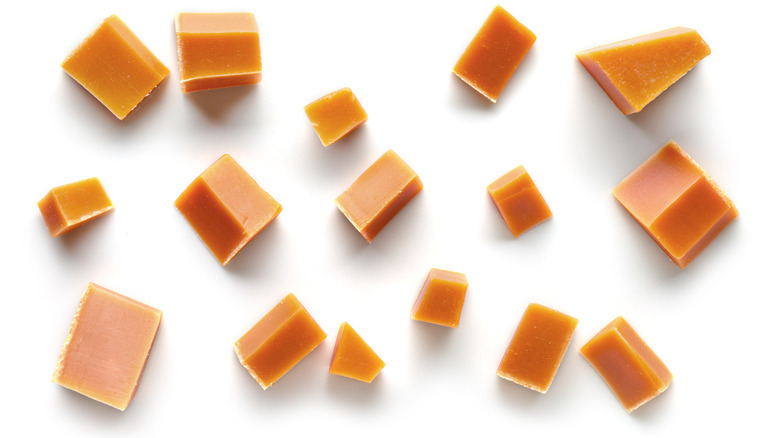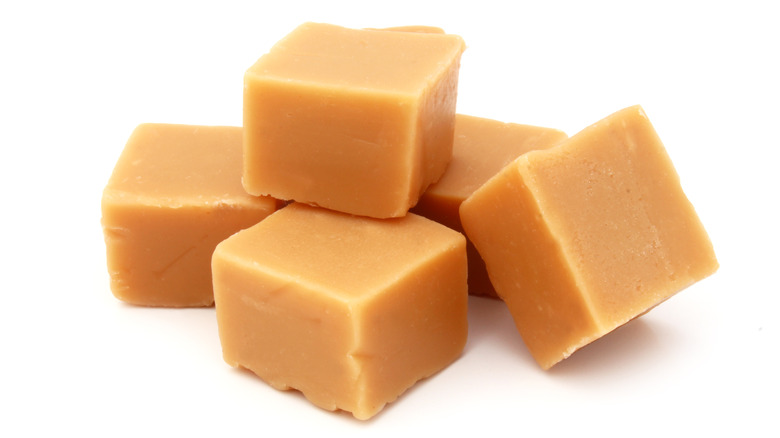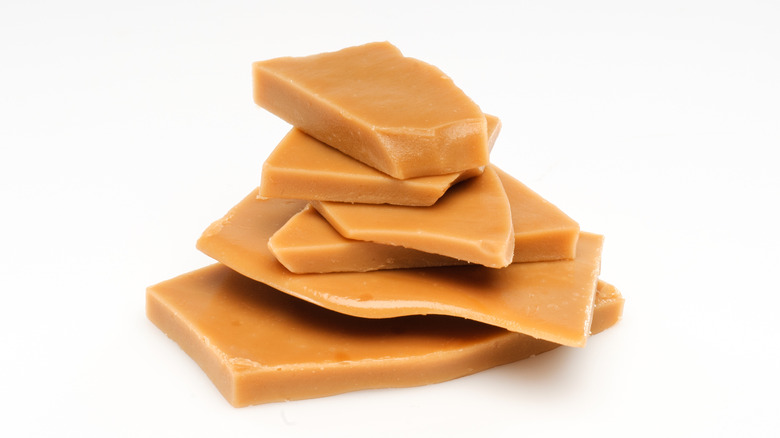Butterscotch Vs. Toffee: What's The Difference?
Have you ever had a butterscotch candy? Perhaps you did when your grandma carried some in her purse and offered it to you on a long car ride. What about toffee, which tastes nearly identical, giving off the same burnt sugar aromas? If you've had either, you'll know that butterscotch candy is nostalgic, with its smooth and velvety texture that practically melts in your mouth. On the other hand, toffee has its own delectable charm, often layered or coated with high-quality chocolate and chopped almonds.
Butterscotch has a whole host of uses when it comes to cooking and baking. You can use it as a topping for ice cream or a filling for cookies and brownies. Toffee is also a great addition to desserts, which adds a toasted flavor and a pleasing crunch. But what are the differences between these two caramelized candies? It's hard to really tell the difference when you're having one after the other, but there are subtle characteristics that you can look out for to know what kind of caramel candy you're eating.
What is butterscotch?
Britannica states that butterscotch is a crunchy, golden candy made from melting brown sugar, butter, and water together. The origins of this simple confectionery can be traced back to 1817 in Doncaster, England, where Samuel Parkinson first invented it. Foods of England found a record of the original butterscotch recipe, which calls for boiling one pound of butter with one pound of sugar, with the addition of some treacle which is a dark brown syrup, like molasses. Today, brown sugar is used instead since it already includes a rich caramelized flavor from its molasses content. In modern recipes, corn syrup is typically added to help prevent crystallization and give the butterscotch a smooth, creamy consistency.
What makes any burnt sugar and butter candy, specifically butterscotch, is the extent to which you boil and cool the candy. According to Webstaurant Store, butterscotch is considered a "soft-crack" candy, which is less pliable than a gummy and can crack easily. This all depends on the temperature you allow your melted sugar and butter to reach: Approximately 270 degrees Fahrenheit. As Exploratorium explains, the more sugar syrup cooks down, the more water evaporates, which increases the sugar content. Butterscotch has a sugar content of a whopping 95%, which is why it is stiffer than something like nougat.
What is toffee?
Toffee is also made of butter and sugar, although certain types even require an addition of cream. BBC Good Food describes the two main varieties of toffee, the brittle version and the more malleable butter toffee version. Toffee, in its brittle form, is the most popular, and for the sake of this article, it will be the topic of discussion. BBC's butter toffee recipe contains cream and is only cooked to the "soft-crack" stage, making it similar in texture and finish to butterscotch. Toffee sans cream, in its original state, comes in brittles or shards, which are often found interspersed in decadent cookies or chocolate bars.
Yes, butterscotch and toffee are made up of the exact same ingredients: Butter and sugar. However, butter toffee contains the addition of cream (Yes, this is confusing). The only remarkable difference between butterscotch and toffee is their texture and sugar content. Simply put, toffee is an overcooked butterscotch — easy to break and with little to no elasticity. Webstaurant Store calls toffee a "hard-crack" candy, which must be heated to a temperature between 295 and 304 degrees F. This allows even more water to evaporate from the mix, increasing the sugar content to 99%.


